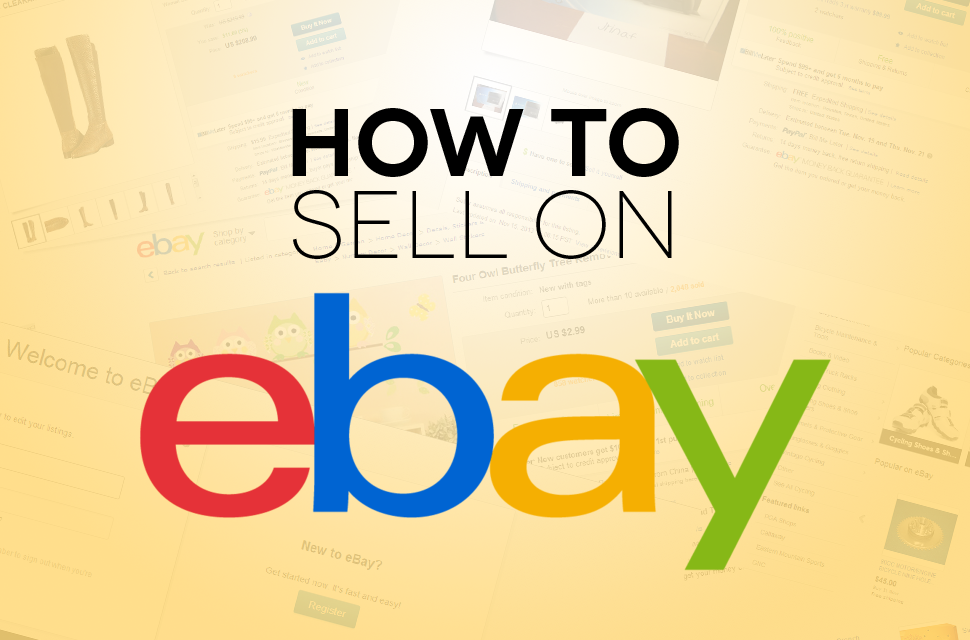Introduction to Selling on eBay:
eBay has become synonymous with online commerce, offering a platform where sellers can reach millions of potential buyers worldwide. Whether you’re an individual looking to declutter your home or a business aiming to expand its reach, eBay provides a powerful platform to sell a wide range of products. How to Sell on eBay; In this comprehensive guide, we will explore the step-by-step process of selling on eBay, from setting up your account to optimizing your listings and maximizing your sales potential.
How to Sell on eBay

Getting Started on eBay:
- Creating Your eBay Account: The first step to selling on eBay is setting up your seller account. We’ll walk through the process of creating an account, including providing necessary information and verifying your identity.
- Understanding eBay’s Fee Structure: eBay charges various fees for selling on its platform, including insertion fees, final value fees, and optional listing upgrade fees. We’ll discuss how these fees work and how to factor them into your pricing strategy.
Choosing What to Sell:
- Identifying Profitable Niches: Successful eBay sellers understand the importance of niche selection. We’ll explore methods for identifying profitable niches, including market research, trend analysis, and assessing demand.
- Evaluating Product Viability: Not all products are suitable for selling on eBay. We’ll discuss factors to consider when evaluating product viability, such as sourcing, competition, and profit margins.
Listing Your Items for Sale:
- Creating Compelling Listings: A well-crafted listing is essential for attracting buyers on eBay. We’ll provide tips for optimizing your listings, including writing compelling titles and descriptions, taking high-quality photos, and setting competitive prices.
- Understanding Listing Formats: eBay offers various listing formats, including auction-style listings, fixed-price listings, and classified ads. We’ll explain the differences between these formats and help you choose the most suitable option for your items.
Managing Your eBay Store:
- Setting Up Your eBay Store: Establishing an eBay store can provide additional branding and marketing opportunities. We’ll guide you through the process of setting up your eBay store, including customizing your storefront and organizing your inventory.
- Managing Inventory: Efficient inventory management is crucial for maintaining accurate listings and fulfilling orders promptly. We’ll discuss best practices for managing your inventory, including tracking stock levels, replenishing inventory, and handling out-of-stock items.

5. Providing Excellent Customer Service:
- Responding to Buyer Inquiries: Timely and professional communication with buyers is essential for building trust and satisfaction. We’ll provide tips for responding to buyer inquiries, addressing concerns, and resolving issues effectively.
- Handling Returns and Refunds: Dealing with returns and refunds is an inevitable part of selling online. We’ll discuss how to establish clear return policies, handle return requests, and minimize the impact of returns on your business.
Shipping and Fulfillment:
- Choosing Shipping Options: Offering fast and affordable shipping options can attract more buyers to your listings. We’ll explore different shipping carriers, services, and packaging options to help you choose the best shipping strategy for your business.
- Printing Shipping Labels: eBay offers convenient tools for printing shipping labels and managing shipments directly from your account. We’ll walk you through the process of printing shipping labels, scheduling pickups, and tracking shipments.
Promoting Your Listings:
- Utilizing Promotional Tools: eBay offers various promotional tools to help sellers increase visibility and attract more buyers. We’ll discuss options such as Promoted Listings, Markdown Manager, and eBay Deals, and how to leverage them to boost your sales.
- Implementing External Marketing Strategies: Beyond eBay’s platform, sellers can use external marketing channels to drive traffic to their listings. We’ll explore strategies such as social media marketing, email campaigns, and search engine optimization (SEO) to promote your eBay store.
Analyzing Performance and Optimization:
- Monitoring Your Sales Metrics: Tracking key performance metrics is essential for evaluating the success of your eBay business. We’ll discuss metrics such as sales volume, conversion rate, and average selling price, and how to interpret them to make informed decisions.
- Iterating and Optimizing: Continuous optimization is key to long-term success on eBay. We’ll provide tips for analyzing performance data, identifying areas for improvement, and implementing changes to optimize your listings and maximize your sales potential.

Conclusion:
Selling on eBay offers a wealth of opportunities for individuals and businesses alike to reach a global audience and generate significant revenue. By following the strategies outlined in this guide, you can establish a successful eBay selling business and unlock your full potential in the world of e-commerce. Whether you’re a novice seller or an experienced entrepreneur, eBay provides a platform where you can thrive and succeed. Start your eBay selling journey today and embark on the path to e-commerce success.




One Comment on “How to Sell on eBay in 2024 (Step by Step Guide)”